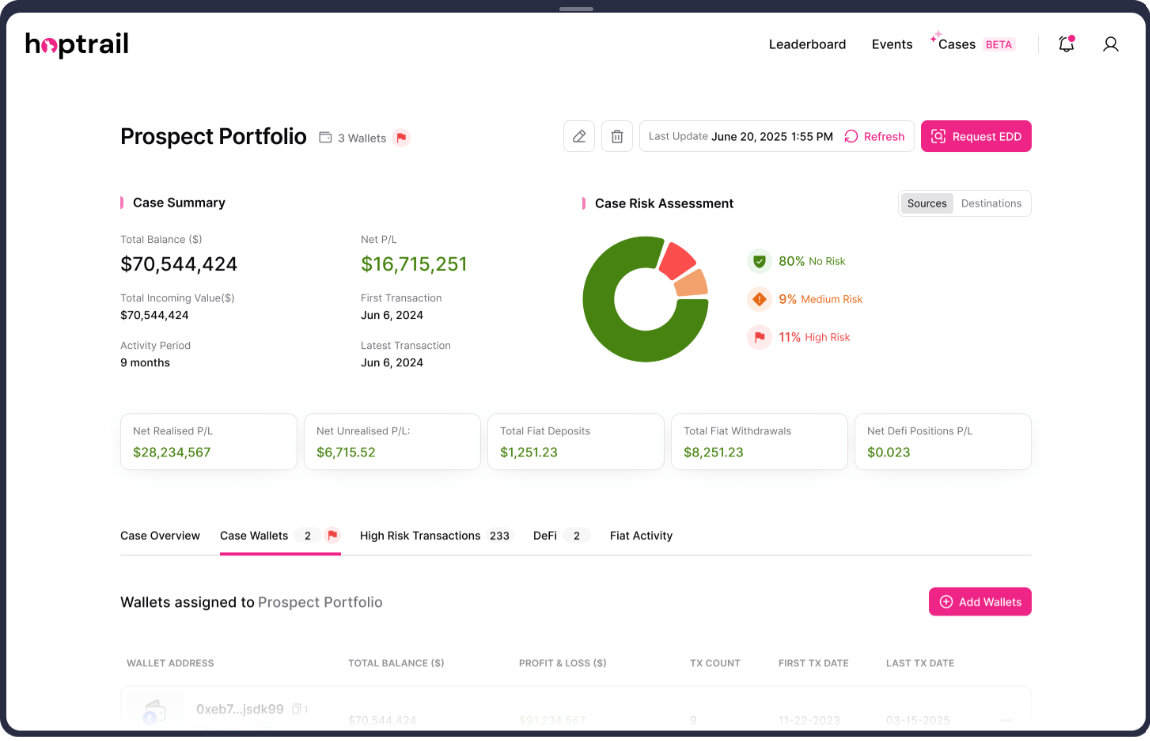On-Chain Data: No jargon. Just clear risk analysis.

At Hoptrail, we build intuitive crypto risk products for compliance professionals. That means data. Lots of it.
But collating data also brings responsibilities to surface it in a clear, detailed manner. We’re not here to throw raw data at you. We’re here to empower informed risk-based decision-making and win the trust of traditional finance.
Our efforts to do that mean that Hoptrail is now among the largest crypto risk intelligence providers globally. Our data is the product of tens of thousands of hours of research and development – blending blockchain data with publicly available information to create and curate not just the world’s largest risk data set, but the most accurate too.
We collect data on everything in the digital asset ecosystem – from entities, and events, to wallets and tokens. This enables our clients to develop their knowledge and get comfortable with crypto data; and to harness the blockchain as a critical compliance function in its own right.
This means the potential opportunities are significant. Access to a new asset class and a new generation of wealthy investors for financial services; and the ability to access financial services for the crypto ecosystem.
Driving Global Standards in Data Collection
We often get asked about how we collect our data; how we verify it; and how we use it. In practical terms our data is split into two parts:
- On-Chain data: Wallet tags, types, and labels; token risk analytics
- Off-Chain data: Compliance and AML/CFT data on VASPs; AML Risk Scoring
The goal with our on-chain data, as with everything, is to provide clear and accurate tagging information. To do that we break our typologies into 40 possible categories (or Types), with a further 134 sub-types.
A typical type might be ‘Exchange’ or ‘Darknet’, while a sub-type could be ‘Hot Wallet’, ‘Prime Broker’, or ‘Marketplace’. This is to ensure we are tagging every wallet as accurately as possible with multiple descriptors. Where we need to, we supplement this data with labels – additional descriptions on addresses to fully explain our tags. This might be information on an event relevant or that address, but it could equally be further detail on the type of service the tagged entity offers.
We now have a database of more than 230 million tagged wallets, comprising addresses tied to a range of services – from exchanges and DEXs to darknet marketplaces, mixing services and sanctioned entities.

What makes up that 250 million number? Over half the addresses are tied to cryptocurrency exchanges. Roughly 12% of addresses in our systems are tied to high-risk entities and events. These include, among other things, sanctioned addresses, as well as those tied to terrorist groups, abusive material, right wing extremists, hacks, scams, and darknet marketplaces.

Gathering this data combines internally developed algorithms, clustering heuristics, in-depth public records research, and blockchain tracing. Our teams devote substantial time tracking down entity data so ensure that when wallets are screened Hoptrail is providing the most complete picture of their sources of funds.
Each wallet we identify is subject to an internal vetting procedure. This includes assessing the source of the data, cluster testing, and wallet screening for further validators on transaction patterns.
Verified tagged addresses and their meta data are stored internally with information on where, when and how we found it. This means we retain vital data on the provenance of our tags which we can produce when queried on an address.
Where we cannot be certain that a tag is correct, we record it internally, but it is not displayed in our Explorer. We estimate these shadow tags constitute a further 10 – 20 million addresses in our systems.
Providing Critical Context
With some transaction monitoring tools, detailed information on an entity or event found while screening is often not available. This can lead to data misinterpretation, and may culminate in client rejection, off-boarding, or – in some cases – de-banking.
We believe that big compliance decisions require much more data. This includes background profiles on entities, context on high-risk events, and risk-based detail that might show what initially looked like a concern can be mitigated.
To do this, Hoptrail combines its on-chain tags with our off-chain generated profiles on entities and events – from exchanges and DEXs to hacks and sanctions events. So when you see a potentially risky wallet you can surface data on it immediately while browsing by clicking on that entity or event.


But this data isn’t just for high-risk events. We surface data on a wide variety of entities. Clicking on Binance in the Sources of Funds table above will bring up AML, regulatory, litigation, licensing, and financial data on the exchange too. Below displays the ‘Solvency Transparency’ and ‘Licensing’ information on the entity - all of which can be accessed while you browse the Explorer.

The point is to provide clear, detailed risk information instantly - when you need it. The blockchain is a very powerful compliance tool and with the right data it can be extremely valuable for institutions looking to engage with crypto in a safe, compliant manner.
What’s Next?
Much more on how we collect, categorise, and display our off-chain data will be provided in the next installment.
But there is far more that we are doing to enhance the accuracy of our entire data set, including the introduction on AI and some next-generation enhancements for Ethereum. Hoptrail will be publishing much more on our research and development work over the coming months.
We’d love to hear from you. Reach out to us with any questions at info@hoptrail.io.
dataanalyticson-chainAMLcrypto

Cases: new source of wealth capabilities and upcoming features

Why we built Cases: A personal note on solving the crypto source of wealth headache

Hoptrail's Crypto Source of Wealth Reports: A Guide
Subscribe to the Hoptrail newsletter
Sign up with your email address to get the latest insights from our crypto experts.
